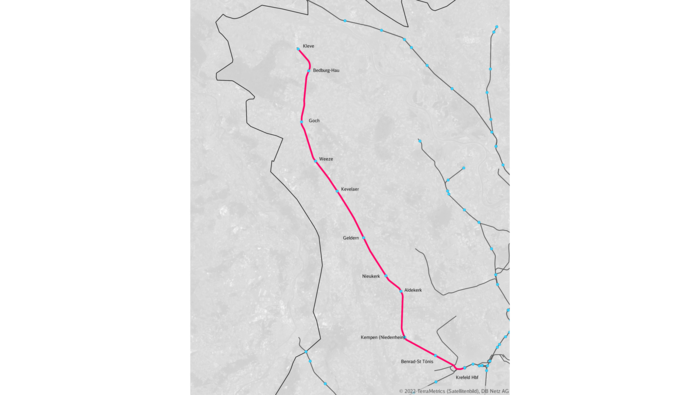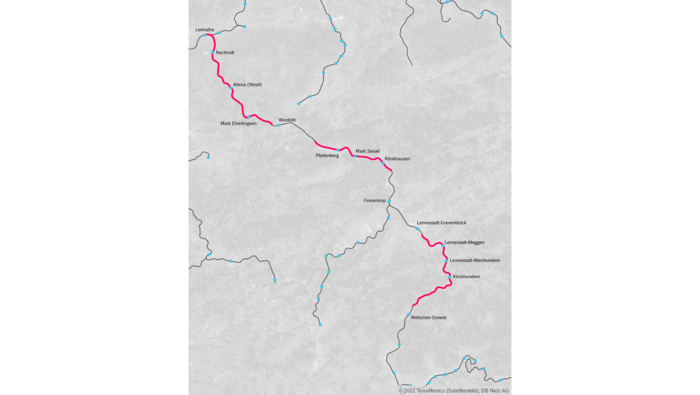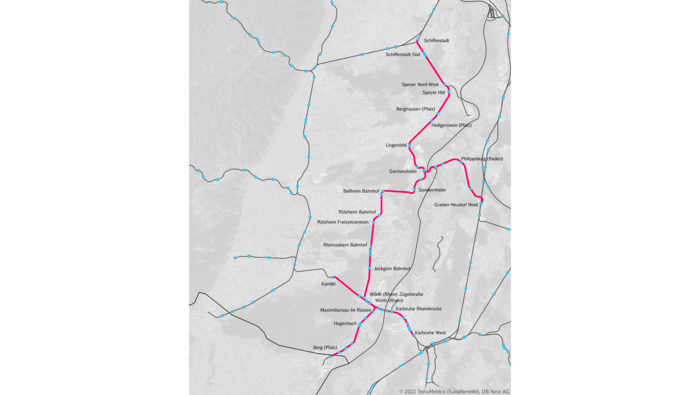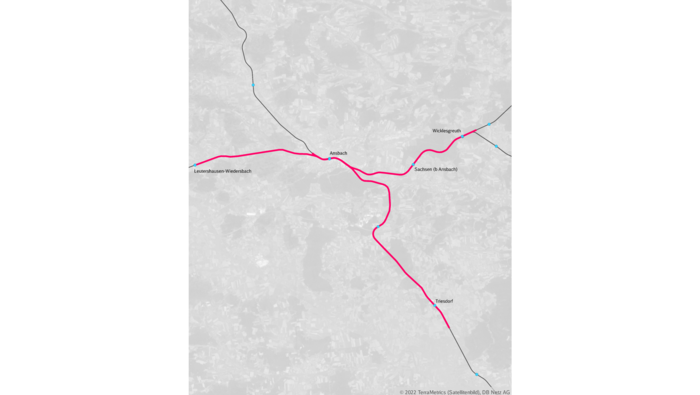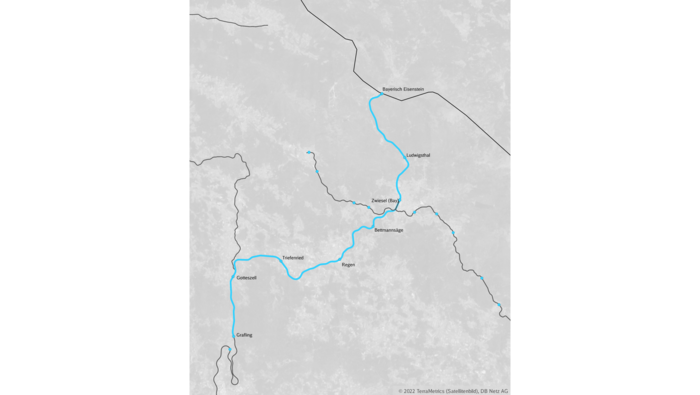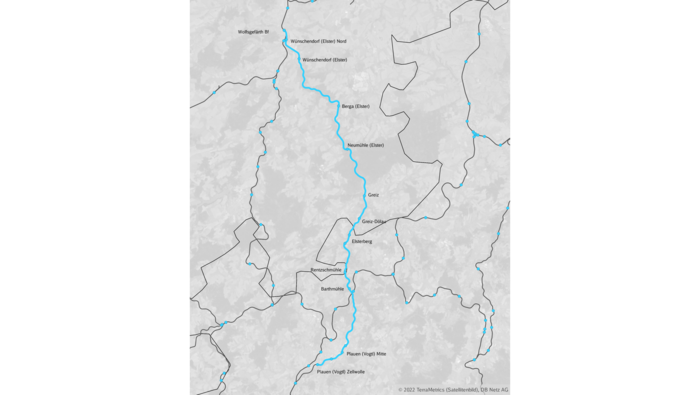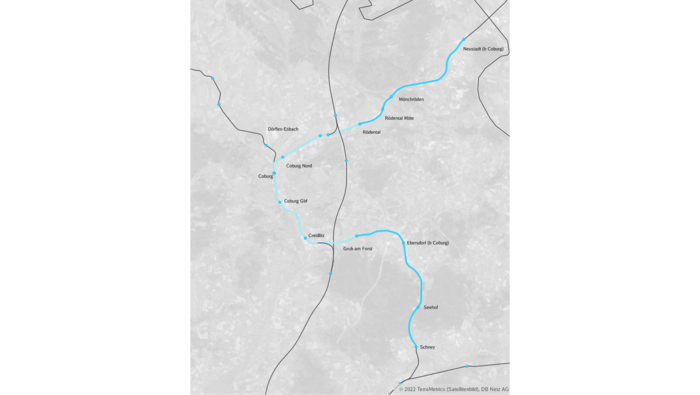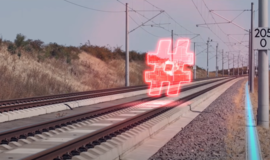
Fast-Track Programme
Increased reliability, lower maintenance thanks to modern signalling technology. First rollout as early as 1.5 years after construction begins in 2022. Findings being collected for the rollout of Digitale Schiene Deutschland (Digital Rail Germany). This is the Fast-Track Programme.
The name says it all. The ‘Fast-Track Programme’ (Schnellläuferprogramm: SLP) – an initiative of the German federal government, the rail industry and Deutsche Bahn (DB) – is an economic stimulus programme designed to combat the consequences of the coronavirus pandemic, safeguard jobs and strengthen industry. To this end, the federal government is providing funds of €500 million throughout 2020 and 2021, €100 million of this in 2020. In a short time, in seven projects, existing signal and switch technology will be replaced by modern, digital technology. Projects like these usually take much longer to realise, but processes are being improved and standards established to accelerate project execution, in close cooperation with industry. This is an important building block for the digitalisation of the rail network within the framework of the DSD programme.
The SLP began with the signing of the agreement by all parties on 2 September, 2020. It aims to accelerate the DSD’s goal of equipping the rail network with digital control and safety technology. Several years earlier than planned, Germany will benefit from a digital and forward-looking rail network. This will make it possible to achieve transport and climate policy goals and strengthen Germany as a business location.
Ambitious goals like these require new approaches – ones that offer high efficiency and short implementation times, as being developed and tested as part of the SLP. Lean processes and new standards form the foundation of the acceleration. As a result, valuable knowledge is being gained for the DSD rollout. This is a truly unique approach.
"With the SLP, the federal government, the rail industry and DB are essentially pursuing two goals. Firstly, securing jobs in the industry and strengthening employment. The other is to gather valuable knowledge for the rollout of DSD."
Frank Gülicher, DB AG Representative for BIM Infrastructure and Head of DSD Project Portfolio (Digitale Schiene Deutschland, DB InfraGO AG)
The SLP projects
To achieve the quick start time and fast pace of the SLP, a total of seven projects were selected, with the parameters of offering comparatively low complexity and minimal impact on ongoing operations and other construction works. The projects are divided into two clusters. The four projects of Cluster 1 are the responsibility of signalling technology manufacturers already established in the German market. The three projects of Cluster 2 are the responsibility of those not yet established in the German market. Through the SLP, these manufacturers will have the opportunity to implement digital interlocking technology in accordance with DB specifications and to obtain approval. Through the entry of new signalling companies, market expansion is to be achieved, creating higher capacity and broader know-how for the DSD rollout.
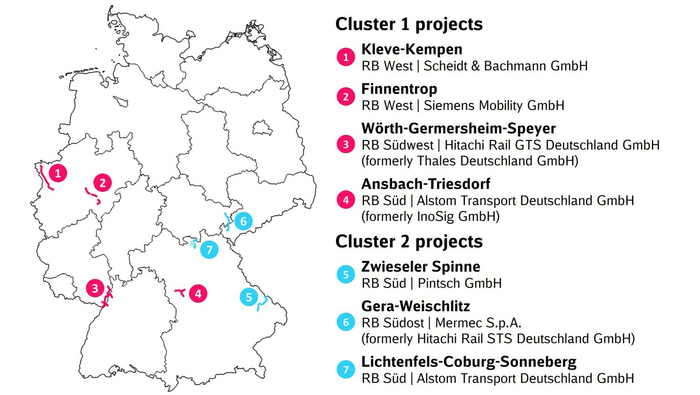
Technically, the projects involve a ‘1:1 replacement’ of existing interlocking and level crossing protection technology with new, modern elements that will be upwardly compatible with future DSD targets. The following defined, standardised interfaces will be implemented independently of the manufacturer: SCI-LX (interlocking-level crossing), SCI-ILS (interlocking-interlocking), SCI-CC (interlocking-control system) and SCI-RBC (interlocking-Radio Block Centre). With the help of this technology, the reliability of the rail network is to be increased and maintenance effort reduced. In this way, the rail network will be made more robust. The manufacturer-independent interfaces also enable a sustainable reduction in the number of different technologies. In individual projects, greater flexibility is also achieved through Ks signalling systems or integrated train control, for example. In some cases, track-change operations are being retrofitted – with the advantage of time gains at construction sites with single-track operations. The lines are thus being made fit for the digital age.
Cluster 1 projects
In the Cluster 1 projects, electronic interlockings (Elektronische Stellwerke: ESTW) are being built with digital elements and standardised interfaces. Operations are scheduled to begin late summer 2022.
Kleve-Kempen
On the Kleve-Kempen section of the line along the Lower Rhine’s left bank, interlockings in Kleve, Bedburg-Hau, Goch, Weeze, Kevelaer, Geldern, Vernum, Nieukerk, Aldekerk and Kempen will be replaced by modern electronic technology. The company Scheidt & Bachmann GmbH is building 11 electronic ZSB 2000 interlockings at these locations, which will be operated from the six interlockings in Kleve, Bedburg-Hau, Goch, Kevelaer, Nieukerk and Kempen. These will be upgraded accordingly. The first section of the Kleve-Geldern line began operations on 4th December 2021. The entire line followed end of November 2022.
In numbers:
● Laying 175 kilometers of cable
● Renewal of around 170 signals and 30 point machines
● Technical upgrade or renewal of 76 level crossings
● Installation of one signal boom
Press releases (in German only)
● Start of construction: 11th Mai 2021
● Building site visit by Ronald Pofalla and Hendrik Wüst: 6th July 2021
● Construction works first section: 30th July 2021
● Construction works second section: 31st May 2022
● Successful begin of operations: 06th December 2022
Finnentrop
Modernisation will take place on the Ruhr-Sieg line on these three sections:
- Letmathe-Nachrodt-Altena-Werdohl,
- Werdohl-Plettenberg-Finnentrop and
- Grevenbrück-Lennestadt-Meggen, -Altenhundem, -Kirchhundem-Welschen-Ennest.
The three 30- to 50-year-old interlockings in Altenhundem/Meggen, Plettenberg and Nachrodt/Altena will be replaced by modern Simis-D interlocking technology from Siemens AG. The interlockings will be connected to the existing central electronic interlocking in Finnentrop, which will be upgraded. Since summer 2022, the Letmathe-Kreuztal line is continuously operated by Finnentrop traffic controllers.
In numbers:
● Laying 385 kilometers of cable.
● Renewal of around 235 signals, 112 additional indicators and 73 point machines
● Technical upgrade or complete renewal of 15 level crossings
● Installation of nine signal booms
Press releases (in German only)
- Start of construction: 31st March 2021
- Begin operations: 4th May 2022
- Successful begin of operations: 1st June 2022
Wörth-Germersheim-Speyer
On the Wörth-Germersheim-Speyer line, the seven existing interlockings in Speyer, Germersheim, Wörth, Philippsburg and Rülzheim will be replaced by modern ESTW L90 signalling technology from Thales Deutschland GmbH. Modern ESTW-A interlockings will be installed in Philippsburg, Speyer and Wörth stations. Operation will be via a new central ESTW in Germersheim. From Speyer-Germersheim and Germersheim-Wörth, a track-change operation including block consolidation will be established to improve the quality of the service. Operations began in three stages in 2022.
In numbers:
● Laying 346 kilometers of cable
● Renewal of around 283 signals, 182 additional indicators and 111 point machines
● Technical upgrade or complete renewal of 40 level crossings
● Installation of 5 signal booms
Press releases (in German only)
- Start of construction: 16th April 2021
- Begin operations first section: 24th June 2022
- Construction works second section: 25th July 2022
- Successful begin of operations: 12th December 2022
Ansbach-Triesdorf
The project includes the two lines Ansbach-Triesdorf and Leutershausen-Wiedersbach-Ansbach-Wicklesgreuth. The company InoSig GmbH is replacing the old interlockings in Ansbach and Triesdorf stations, which are around 55-years-old, with modern B950 electronic interlockings.
In numbers:
● Laying 384 kilometers of cable
● Renewal of 192 signals, 123 additional indicators and 84 point machines
● Technical upgrade or complete renewal of one level crossing
● Use of one existing signal boom
Press releases (in German only)
- Start of construction: 28th April 2021
Cluster 2 projects
In the Cluster 2 projects, digital interlockings (Digitale Stellwerke: DSTW) will be built. Development work is being carried out in 2021 so construction can begin in 2022. Launch is scheduled for 2024 and 2025.
Zwieseler Spinne
The Zwieseler Spinne rail routes (around the city of Zwiesel) are being equipped with modern signalling and interlocking technology. Pintsch GmbH is replacing the six interlockings in Grafling, Gotteszell, Triefenried, Bayerisch Eisenstein and Zwiesel with digital interlocking technology from PinMovio. From December 2024, the central digital interlocking in Zwiesel will control these routes. The five technical modules are located in Zwiesel, Grafling, Gotteszell, Triefenried and Bayerisch Eisenstein.
In numbers:
● Laying 204 kilometres of cable
● Renewal of 124 signals and 23 point machines
● Upgrading or renewal of 15 level crossings
Press releases (in German only)
- Start of construction: 30th May 2022
Gera-Weischlitz
Hitachi Rail STS Deutschland GmbH is renewing a total of 12 interlockings on the Gera-Weischlitz route in Wünschendorf (Elster), Berga (Elster), Greiz, Greiz-Dölau, Elsterberg, Barthmühle and Plauen (Vogtl) Unterer Bahnhof. A digital interlocking will be built in Plauen and seven track field concentrators (Gleisfeldkonzentratoren: GFK) will be set up at these locations. Commissioning is scheduled for December 2025. From then, the route will be operated from Plauen (Vogtl.) Unterer Bahnhof.
In numbers:
● Laying 60 kilometres of cable
● Renewal of 201 control units (signals and point machines)
● Technical upgrade or complete renewal of 11 level crossings
Press releases (in German only)
- Start of construction: 6th July 2023
Lichtenfels-Coburg-Sonneberg
On the Lichtenfels-Coburg-Sonneberg route, the nine previous interlockings in Neustadt/Coburg, Rödental, Ebersdorf/Coburg, Seehof, Coburg, Herzogsweg and Creidlitz will be renewed. Alstom Transport Deutschland GmbH is building a central DSTW in Coburg and five electronic technical modules in Neustadt/Coburg, Ebersdorf/Coburg, Herzogsweg, Coburg and Creidlitz. The route will continue to be operated from Coburg. Commissioning is scheduled for December 2024.
In numbers:
● Laying 40 kilometers of cable
● Renewal of around 51 signals and 10 point machines
● Technical upgrade or complete renewal of 26 level crossings
● Installation of one signal boom
Press releases (in German only)
- Start of construction: 28th October 2022

